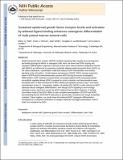Sustained epidermal growth factor receptor levels and activation by tethered ligand binding enhances osteogenic differentiation of multi-potent marrow stromal cells
Author(s)
Platt, Manu O.; Roman, Arian J.; Wells, Alan; Lauffenburger, Douglas A.; Griffith, Linda G.
DownloadGriffith_Sustained epidermal.pdf (1.967Mb)
OPEN_ACCESS_POLICY
Open Access Policy
Creative Commons Attribution-Noncommercial-Share Alike
Terms of use
Metadata
Show full item recordAbstract
Epidermal growth factor receptor (EGFR)-mediated signaling helps regulate bone development and healing through its effects on osteogenic cells. Here, we show how EGFR activity and osteogenic differentiation responses in primary human bone marrow-derived multipotent stromal cells (MSCs) are influenced by presenting covalently tethered epidermal growth factor (tEGF) on the culture substratum, a presentation mode that reduces EGFR internalization and restricts signaling to the cell surface. In both absence and presence of tEGF, MSCs increase expression levels of EGFR and its heterodimerization partner HER2 during the course of osteogenic differentiation. tEGF substrata increased levels of phosphorylated EGFR and phosphorylated extracellular regulated kinase (ERK) compared to control substrata, and these elevations were associated with a twofold enhancement of MSC alkaline phosphatase activity at day 7 and matrix mineralization at day 21. Surprisingly, addition of soluble EGF (sEGF) to cells cultured on tEGF substrata reduces osteogenic differentiation, even though EGFR signaling is more strongly activated in acute, short-term manner by sEGF treatment than by tEGF treatment. A striking concomitant result of the sEGF effects is near-complete downregulation of EGFR and HER2, demonstrating that the tEGF/EGFR interaction is dynamically reversible even though temporally sustained. Taken together, our results show that enhanced MSC osteogenic differentiation corresponds to a sustained combination of receptor expression and ligand presentation, both of which are maintained by tEGF.
Description
Author Manuscript 2011 April 29.
Date issued
2009-06Department
Massachusetts Institute of Technology. Department of Biological EngineeringJournal
Journal of Cellular Physiology
Publisher
Wiley Blackwell
Citation
Platt, Manu O. et al. “Sustained Epidermal Growth Factor Receptor Levels and Activation by Tethered Ligand Binding Enhances Osteogenic Differentiation of Multi-potent Marrow Stromal Cells.” Journal of Cellular Physiology 221.2 (2009): 306–317.
Version: Author's final manuscript
ISSN
0021-9541
1097-4652